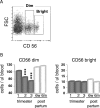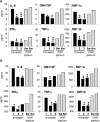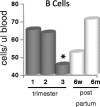Characterizing the pregnancy immune phenotype: results of the viral immunity and pregnancy (VIP) study
- PMID: 22198680
- PMCID: PMC7086597
- DOI: 10.1007/s10875-011-9627-2
Characterizing the pregnancy immune phenotype: results of the viral immunity and pregnancy (VIP) study
Abstract
Purpose: The increased risk of morbidity and mortality from certain microbial infections and the demonstrated improvements in the clinical course of some autoimmune diseases support the existence of pregnancy-related alterations in immune status. Elucidating the changes in innate and adaptive immunity during gestation may improve pregnancy outcomes and facilitate the development of targeted therapies for autoimmune diseases.
Method: The Viral Immunity and Pregnancy (VIP) study evaluated over 50 subjects longitudinally at three time points during pregnancy and at two time points post-delivery. Leukocyte enumeration was performed; functional responses of NK cells and CD4 T cells were analyzed, and soluble factors such as cytokines, defensins, and steroid hormones were measured in maternal blood.
Results: In comparison to the post-partum period, the latter part of pregnancy was characterized by significant increases in blood phagocytes and pDCs and decreases in the number and activity of NK and T cells. Alterations were found in antimicrobial proteins and serum cytokines.
Conclusions: These data show that pregnancy is not a period of immunosuppression but an alteration in immune priorities characterized by a strengthening of innate immune barriers and a concomitant reduction in adaptive/inflammatory immunity in the later stages of pregnancy.
Figures








References
Publication types
MeSH terms
Grants and funding
LinkOut - more resources
Full Text Sources
Other Literature Sources
Medical
Research Materials

